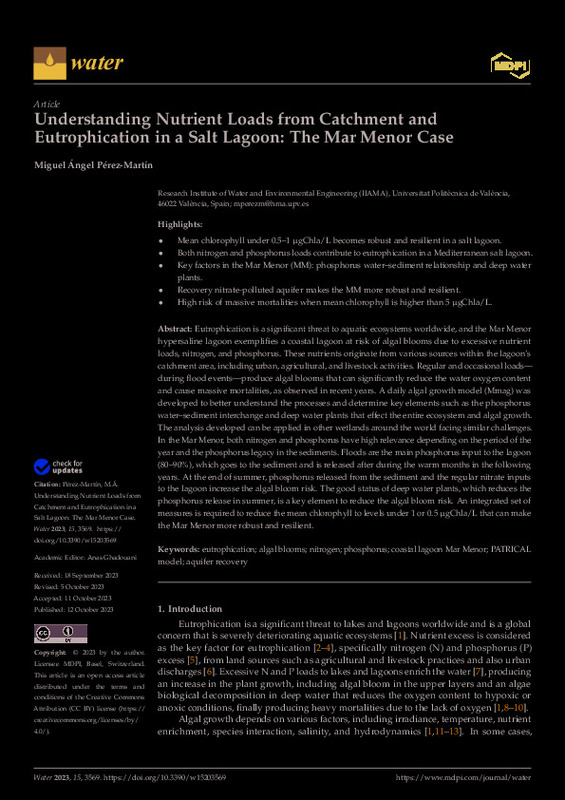JavaScript is disabled for your browser. Some features of this site may not work without it.
Buscar en RiuNet
Listar
Mi cuenta
Estadísticas
Ayuda RiuNet
Admin. UPV
Understanding Nutrient Loads from Catchment and Eutrophication in a Salt Lagoon: The Mar Menor Case
Mostrar el registro sencillo del ítem
Ficheros en el ítem
| dc.contributor.author | Pérez-Martín, Miguel Ángel
|
es_ES |
| dc.date.accessioned | 2024-01-10T19:02:53Z | |
| dc.date.available | 2024-01-10T19:02:53Z | |
| dc.date.issued | 2023-10 | es_ES |
| dc.identifier.issn | 2073-4441 | es_ES |
| dc.identifier.uri | http://hdl.handle.net/10251/201729 | |
| dc.description.abstract | [EN] Highlights Mean chlorophyll under 0.5-1 mu gChla/L becomes robust and resilient in a salt lagoon. Both nitrogen and phosphorus loads contribute to eutrophication in a Mediterranean salt lagoon. Key factors in the Mar Menor (MM): phosphorus water-sediment relationship and deep water plants. Recovery nitrate-polluted aquifer makes the MM more robust and resilient. High risk of massive mortalities when mean chlorophyll is higher than 5 mu gChla/L.Abstract Eutrophication is a significant threat to aquatic ecosystems worldwide, and the Mar Menor hypersaline lagoon exemplifies a coastal lagoon at risk of algal blooms due to excessive nutrient loads, nitrogen, and phosphorus. These nutrients originate from various sources within the lagoon's catchment area, including urban, agricultural, and livestock activities. Regular and occasional loads-during flood events-produce algal blooms that can significantly reduce the water oxygen content and cause massive mortalities, as observed in recent years. A daily algal growth model (Mmag) was developed to better understand the processes and determine key elements such as the phosphorus water-sediment interchange and deep water plants that effect the entire ecosystem and algal growth. The analysis developed can be applied in other wetlands around the world facing similar challenges. In the Mar Menor, both nitrogen and phosphorus have high relevance depending on the period of the year and the phosphorus legacy in the sediments. Floods are the main phosphorus input to the lagoon (80-90%), which goes to the sediment and is released after during the warm months in the following years. At the end of summer, phosphorus released from the sediment and the regular nitrate inputs to the lagoon increase the algal bloom risk. The good status of deep water plants, which reduces the phosphorus release in summer, is a key element to reduce the algal bloom risk. An integrated set of measures is required to reduce the mean chlorophyll to levels under 1 or 0.5 mu gChla/L that can make the Mar Menor more robust and resilient. | es_ES |
| dc.description.sponsorship | This work was supported by the Spanish Ministry for the Ecological Transition and the Demographic Challenge. | es_ES |
| dc.language | Inglés | es_ES |
| dc.publisher | MDPI AG | es_ES |
| dc.relation.ispartof | Water | es_ES |
| dc.rights | Reconocimiento (by) | es_ES |
| dc.subject | Eutrophication | es_ES |
| dc.subject | Algal blooms | es_ES |
| dc.subject | Nitrogen | es_ES |
| dc.subject | Phosphorus | es_ES |
| dc.subject | Coastal lagoon Mar Menor | es_ES |
| dc.subject | PATRICAL model | es_ES |
| dc.subject | Aquifer recovery | es_ES |
| dc.subject.classification | INGENIERIA HIDRAULICA | es_ES |
| dc.title | Understanding Nutrient Loads from Catchment and Eutrophication in a Salt Lagoon: The Mar Menor Case | es_ES |
| dc.type | Artículo | es_ES |
| dc.identifier.doi | 10.3390/w15203569 | es_ES |
| dc.rights.accessRights | Abierto | es_ES |
| dc.contributor.affiliation | Universitat Politècnica de València. Escuela Técnica Superior de Ingenieros de Caminos, Canales y Puertos - Escola Tècnica Superior d'Enginyers de Camins, Canals i Ports | es_ES |
| dc.description.bibliographicCitation | Pérez-Martín, MÁ. (2023). Understanding Nutrient Loads from Catchment and Eutrophication in a Salt Lagoon: The Mar Menor Case. Water. 15(20):1-16. https://doi.org/10.3390/w15203569 | es_ES |
| dc.description.accrualMethod | S | es_ES |
| dc.relation.publisherversion | https://doi.org/10.3390/w15203569 | es_ES |
| dc.description.upvformatpinicio | 1 | es_ES |
| dc.description.upvformatpfin | 16 | es_ES |
| dc.type.version | info:eu-repo/semantics/publishedVersion | es_ES |
| dc.description.volume | 15 | es_ES |
| dc.description.issue | 20 | es_ES |
| dc.relation.pasarela | S\500831 | es_ES |
| dc.contributor.funder | TECNOLOGIAS Y SERVICIOS AGRARIOS, S.A. S.M.E. M.P. | es_ES |
| dc.contributor.funder | UTE SERS C.I.A,SAU-FULCRUM P.A.P.,SAU-COORD PLANES HIDROLOG. | es_ES |
| dc.contributor.funder | Ministerio para la Transición Ecológica y el Reto Demográfico | es_ES |
| dc.subject.ods | 06.- Garantizar la disponibilidad y la gestión sostenible del agua y el saneamiento para todos | es_ES |
| dc.subject.ods | 08.- Fomentar el crecimiento económico sostenido, inclusivo y sostenible, el empleo pleno y productivo, y el trabajo decente para todos | es_ES |
| dc.subject.ods | 12.- Garantizar las pautas de consumo y de producción sostenibles | es_ES |
| dc.subject.ods | 14.- Conservar y utilizar de forma sostenible los océanos, mares y recursos marinos para lograr el desarrollo sostenible | es_ES |








